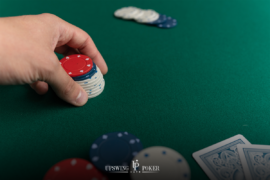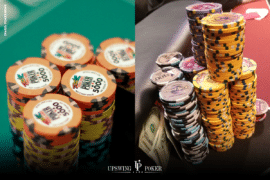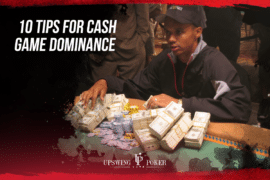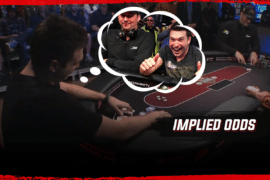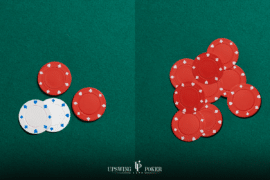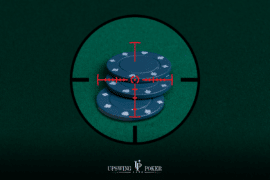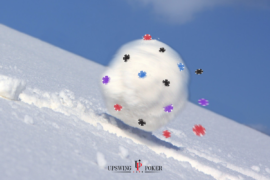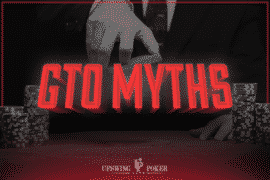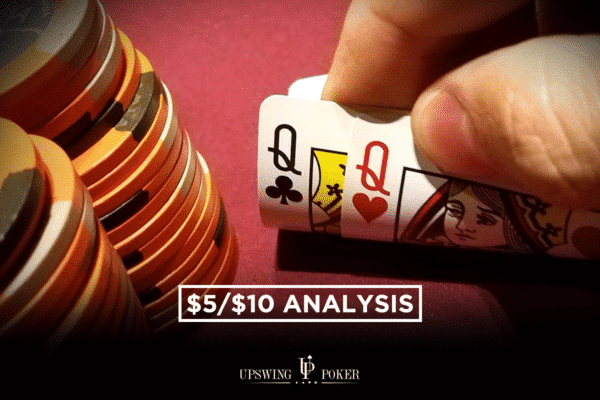
$1,000 Cash Game Insights from a High Stakes Veteran
Ready to improve your live cash game skills? Today we are going to look at three hands that Doug Polk played during a $5/$10 cash game session at the Aria.
(This session was documented in a vlog on Doug’s YouTube channel a while back — watch it here.)
Let’s get started.
Hand #1
9-Handed. Effective Stack $1,000.
Doug is dealt K♠ Q♦ in the big blind
5 folds, cutoff raises to $40, button calls, Doug calls.
Squeezing with this hand would be reasonable, but considering how poorly KQo plays against a 4-bet, calling should be the higher frequency play.
Flop ($125): 4♥ 3♠ 2♣
Doug checks, cutoff checks, button checks.
Doug checks, as he always does when out of position against the preflop aggressor.
Turn ($125): (4♥ 3♠ 2♣) J♦
Doug bets $100, cutoff raises to $240, button folds, Doug folds.
Cutoff wins $225.
Here’s what Doug had to say about his bet on the turn:
In the big blind, I feel like this is a pretty good spot for KQ to take a stab. I have two over cards to top pair so I could definitely value bet that. Another interesting thing about this spot is that I block KJ and QJ, which are going to be some of the most common hands that turn top pair. My removal is decent and my equity is pretty solid, so I decide to bet $100 into $125.
Even though the turn raise got Doug to fold, he does not believe that his opponent’s play makes sense given the situation:
I would have to advocate for the cutoff never raising at all, with my logic being that they are almost never going to have nutted hands. If they have a Jack, it is not two pair because he is not raising J4, J3, or J2 from the cutoff.
Also, if he has a hand like a straight, he is going to mainly be betting the flop. If he decides to check the flop, he should probably just call the turn to protect some of his weaker hands in that call range, and that way if I check and he bets on the river, he doesn’t just have a Jack — he can have some of those stronger hands.
If you start raising a bunch of your hands on the turn — when the big blind can have sets, 65, A5, or two pair — you are really asking for it when you raise here. The button folded and it got back to me and I decided to let KQ go, but if I had 75, 76, or turned a backdoor flush draw, I might just decide to 3-bet him on the turn and go all the way with it because if I did have a hand like a straight or a set, I would take that line to try and stack you.
Note: Want to book more winning poker sessions? Learn battle-tested tactics for live and online poker when you join the Upswing Lab training course. Learn more now!

Hand #2
9-Handed. Effective Stack $1,500.
Doug is dealt 5♣ 4♣ in the lojack
3 folds, Doug raises to $40, hijack calls, cutoff calls, big blind calls.
Flop ($165): 8♣ 6♦ 2♦
Big blind checks, Doug bets $110, hijack calls, big blind calls.
Doug’s strategy on the flop:
This is a pretty good flop for my hand, obviously a great spot to semi-bluff as I can have overpairs and sets. There are a decent number of runouts that I can hit as I also have a backdoor flush draw. Overall, a pretty solid hand to bet.
Turn ($495): (8♣ 6♦ 2♦) 4♠
Big blind checks, Doug bets $330, hijack calls, big blind folds.
Here is Doug’s rationale behind continuing to barrel:
This is a really interesting card because a lot of times when I have straight draws and one pair, I look to check and take my showdown value. But in this spot, it makes a little bit more sense to continue to barrel because the BB can definitely have 75, 64, 84, or 53s. I have some decent removal from these hands with 54, but my hand is also not going to be strong enough to call against larger sizes.
If I check and the HJ bets, in most of those spots I am not going to be able to continue profitably. When you bet a board with a hand like this, you are really committing to betting three streets if the board texture doesn’t change.
It is a lot better to bet a hand like this that has decent removal than it is a hand like diamonds. If I have a flush draw that bricks on the river, [barreling isn’t ideal because flush draws] are the kinds of hands that I want him to have and let go of on the river.
River ($1155): (8♣ 6♦ 2♦ 4♠) Q♦
Doug bets $720, Hijack calls.
Hijack wins $2,595 with K♠ K♥
Here is Doug’s thought process with his river bet:
I will have hands like T9s, which I would definitely triple barrel. It would be a little bit questionable if I would bet that on the turn, but if I did bet, I would definitely continue on the river. The only other hand that I could have that I feel like makes a lot of sense is a hand like 97s, which I would almost certainly take this line with and would want to fire.
But after 97, what hands do I really have here? I’m going to want to bet sets and straights, and I definitely have 75s and a bunch of flushes. If I did go bet-bet on the river with a flush draw, and then got there on the river, I would want to bet that as well. I’m looking at this river spot and I am going to have 20-40 combinations of value, and I can’t only bluff my 97s that weren’t diamonds, because those are only three combos.
So, 54s looks to be one of my most reasonable hands, already a bit of a loose open from the LJ, so it doesn’t really get worse than this for hands I have here that I would want to bluff.
What does Doug think of his opponent’s line?
Hijack tanks and ultimately calls with K♠ K♥. I think there might have been a little bit of ‘I’m just going to try and trap Doug here and call him down with Kings’. Not a terrible idea I guess, but obviously 3-betting preflop would have been preferable.
This can be one of the problems when you have KK and you get runouts like this. What would he have done if the BB raised on the flop or turn? What if the runout was even worse?
The biggest thing to take away from this hand is that sometimes you have to bluff hands without a diamond in them, even on the diamond runouts, because even though it is better to have a high diamond, I am probably not going to bet those on two streets anyways, so I pick one of my most reasonable hands to go three streets with.
Hand #3
9-Handed. Effective Stack $3,230.
Doug is dealt 5♠ 4♦ in the under the gun straddle
Doug straddles to $20, UTG+1 raises to $60, big blind calls, Doug calls.
Preflop was a close decision, but Doug decides to make the call:
The raise was to 3x the straddle and 54 is somewhere around the bottom of what I am calling with the off-suit hands, but close either way.
Flop ($185): 9♥ 3♠ 2♣
Big blind checks, Doug checks, UTG+1 bets $80, big blind calls, Doug raises to $320, UTG+1 raises to $880, big blind folds, Doug raises all-in for $3,140, UTG+1 calls.
That’s some crazy flop action! Let’s hear why Doug chose to bluff all-in with his straight draw on this flop:
The flop comes and gives me an open-ender to the nuts on both sides, and there is no flush draw, which also makes my straight draw a little bit stronger. With 54 in this spot I am looking to mix between call and raise — they are both good.
This is one of the best raise hands you can have on the flop. I am going to have nines, I’m going to have threes, I’m going to have deuces. I’m going to have 93 suited, 92 suited, and 32 suited — all of these hands I have, so I have an array of value bets.
Because of this, we have to mix in some bluffs with hands like 54 and 64 with a backdoor flush draw, and maybe some hands like A4 with a backdoor flush draw too. Open-enders are going to be the heart and soul of hands that we are looking to bluff with.
I check-raise it to $320 and the preflop raiser goes back and makes it $880 and the big blind folds. If he had re-raised to a smaller size, I don’t mind continuing my whole range as a call because I might have some other hands that want to call. If I had a hand like A4s with a backdoor nut-flush draw I would want to call. 64 backdoor nut flush draw may want to call.
When he goes $880, he is really saying that he is bluffing or that he has a hand that he wants to commit with. The way we should approach this in the big blind, is ‘I want to commit with hands like my sets, some two pairs, really that is about it (for value), and a few bluffs.
Well, what are the best bluffs? 54 with a backdoor flush draw, which I don’t have, is the best one, but after that it is really just 54.
If we count the combinations of really strong hands that we have, we have three combos of 99, three of 33, and three of 22, and then we have all of those two pair hands. We are going to have to mix in some hands like our open-enders in order to bluff-jam enough.
I decided to have no flat range and either jam or fold, jamming my open-enders and my two pairs or better. I decided to rip it in for $3,000.
First runout:
Turn: K♠
River: 2♦
Second runout:
Turn: 5♣
River: T♣
UTG+1 wins both boards and $6,525 with J♠ J♥
Although his opponent won this time, Doug isn’t a big fan of how his opponent played this hand:
Personally, I thought that he was a little bit more polar than that because if you get JJ in and you run into a hand like two-pair or a set, you are in pretty bad shape, and when you run into 54, I still have a lot of equity against you, so it is not really a great spot (JJ has 42.27% equity on this flop vs. a range of 99, 33, 22, 93s, 92s, 32s, 54s, and 54o). I asked him why he went with Jacks there, and he said, ‘You’re famous man.’
Hands like this really highlight what it’s like to be a well-known player at a poker table. Players tend to play a lot differently (usually worse), which is almost certainly one of the reasons big name pros like Phil Hellmuth post such incredible results in live tournaments.
That’s it for today!
Want some quick tips for cash games? Read 10 Cash Game Tips for Dominating the Table.
If you want to improve your poker skills with guidance from successful professionals, join the Upswing Lab training course. You will get instant access to 64 high quality poker lessons, 259 preflop charts, and our members-only community for discussing strategy. Learn more now!

